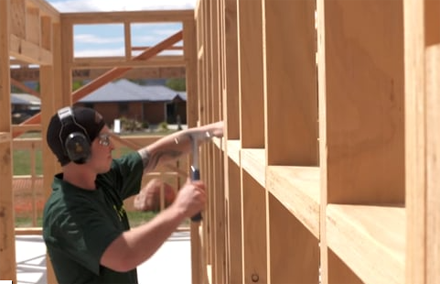
Over their entire lifecycle, New Zealand buildings are responsible for approximately 20% of the country’s greenhouse gas emissions (Thinkstep, 2018). When you also consider that emissions from the construction sector increased 66% in the decade to 2017 (Stats NZ), it’s evident that the building and construction sector has a lot to do to improve their emissions profile. Source: Timberbiz, Scion
As such, the search is on for ways to mitigate some of those carbon dioxide emissions, or to avoid them entirely.
One way is to build with wood. It is scientifically recognised and widely accepted that using wood instead of alternative construction materials greatly reduces greenhouse gas emissions and fossil fuel consumption during the product manufacturing and building construction stages.
Wood processing releases very little carbon, unlike other materials that emit high quantities of CO into the atmosphere. In addition to lowering greenhouse gas emissions, building with wood stores carbon sequestered by trees when they were growing.
Scion Sustainable Architect, Andrea Stocchero, and University of Canterbury Emeritus Professor, Andy Buchanan, suggest quantifying how much carbon is stored in each timber building so that the storage benefit can be accounted for and recognised with possible incentives. This would help policy makers that want to encourage wood product use in construction.
Sustainably harvested wood used in construction can store carbon for a long time, decades and even centuries, depending on the building’s lifespan. And as the building industry begins to implement circular economy principles, which include design for recycling and re-use of building materials, this time could grow considerably. ‘
Mr Stocchero and Prof Buchanan say that a cubic metre of wood with a weight of 500 kg contains approximately 250 kg of carbon (C), which is equivalent to 920 kg of carbon dioxide (CO ) sequestered from the atmosphere. When this wood is used for building construction, that CO equivalent (CO -e) quantity is locked in building materials until the end of their life.
For example, a typical New Zealand timber framed home with a floor area of 200 m contains about 30m of wood and therefore locks up 27 tonnes of CO -e.
The Scion Innovation Hub, currently under construction within Scion’s Rotorua campus, is a bigger example. It is a three-storey building containing 455 m of structural wood, storing approximately 418 tonnes of CO -e. This storage is equivalent to the emissions from 160 return flights from Auckland to London. Impressively, it took only 35 minutes for New Zealand radiata pine to grow the same amount of wood used in the Innovation Hub.
Building with wood is an important measure as New Zealand strives to meet the goals set in the Zero Carbon Bill, the Paris Agreement on Climate Change and the UN Sustainable Development Goals.
Building wood has become increasingly achievable, even for medium-density and tall buildings up to 15 storeys and more.





